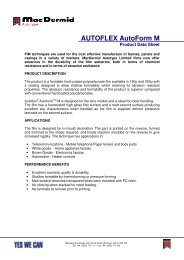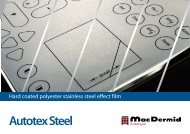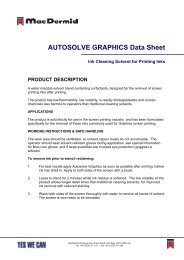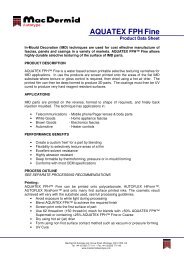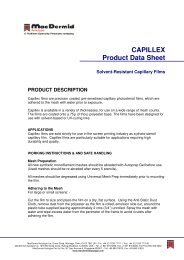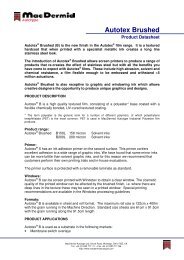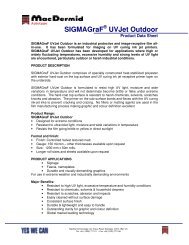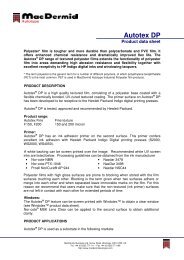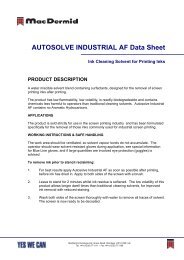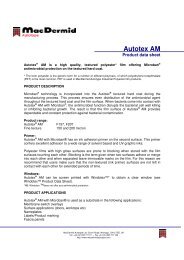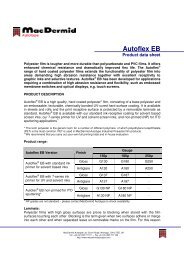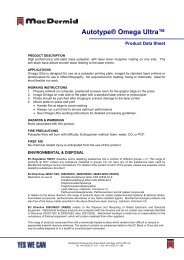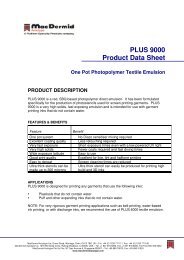Screen E-Book (.PDF) - MacDermid Autotype
Screen E-Book (.PDF) - MacDermid Autotype
Screen E-Book (.PDF) - MacDermid Autotype
- No tags were found...
Create successful ePaper yourself
Turn your PDF publications into a flip-book with our unique Google optimized e-Paper software.
If you do the calculations, you find that 15°moiré comes in at close to the Rule of 4frequency limit (the MRN=3.8 in this case).It’s an obvious moiré when you look at itclosely, but when you go to a normal viewingdistance it disappears. That’s why wecan usually live with it (and, incidentally,the justification for the Rule of 4). Yet thereare times that it seems to stand out fromthe print and look positively ugly. Why?The answer, as hinted above, is to do withamplitude. Anything which increases theamplitude of the 15° moiré can bring it outso it becomes unacceptable.Let me explain. Suppose that every otherdot in the 15° moiré became a little biggerbecause of interactions between printeddots. If you calculate the moiré from that,you don’t see anything very different. It’sstill a 15° moiré. But the amplitude of thatmoiré must be bigger – you are superimposingan extra effect. Or suppose that every3rd interacting dot got a little smaller.Again you’ll have the same 15° moiré butits amplitude is bigger. This makes intuitivesense and is confirmed by theoreticalcalculations. The important thing is thatthese extra effects don’t introduce a newtype of moiré, they just make the currentone more visible. This is a fundamentallaw of moiré and every time I’ve forgottenit, I’ve landed myself in big trouble!Elsewhere in this e<strong>Book</strong> Anna and Daviddiscuss ‘skipping’ and ‘spreading’. These describedot-on-dot printing effects. In thefirst, the presence of a previous dot cancause the new dot to ‘skip’, i.e. to print a tinyfragment of a dot. In the second, the previousdot causes the new dot to print biggerthan it would have been, i.e. you get doton-dotgain. In any 4 colour print you areguaranteed to get skipping or spreading(in some prints I’ve seen both!). All you cando is try to minimize the effects. As skippingis usually very ugly, most of us end upwith the extra dot gain from spreading.Now you can see how 15° moiré can becomeamplified. Each time a second dothappens to be on top of a first dot, the sizeof the second dot will change from whatit would have been. The frequency andangle of moiré do not change, but the amplitudedoes.There’s a quick method for identifying 15°moiré. Count how often a dot goes in andout of phase with another dot in your moirépattern. If it’s around once every 3.8 timesthen you have 15° moiré. This is close toonce every 4 dots, i.e. close to the Rule of4 limit, which is why it’s usually acceptable.You can also measure its angle. It should behalf way between whichever componentsare separated by 15° (or, more precisely, 90°to the half angle). I’ve seen a very distinctive15° moiré as a set of clear lines withinprint using “geometric” Postscript dots. Itwas easy to relate the angle to the anglesof the geometric screens used in this case.But I was puzzled to see lines (rather than a115



